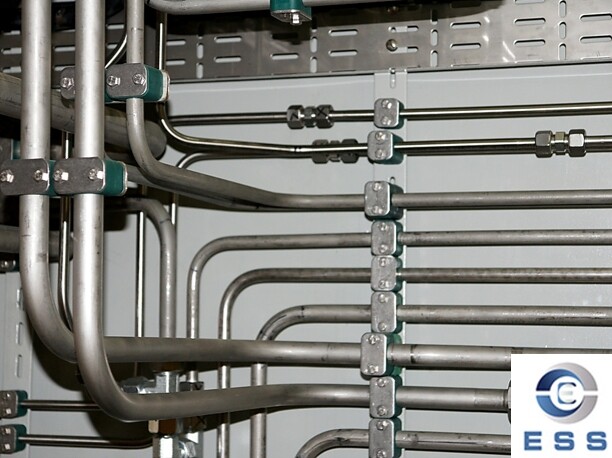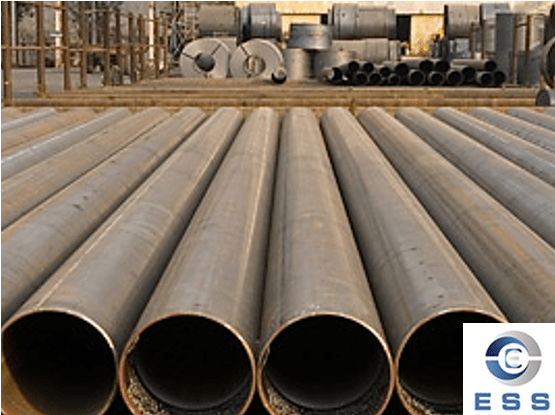
Stainless steel materials
1. Performance advantages
Stainless steel hydraulic
tubes have excellent corrosion resistance, which enables them to resist the
erosion of various corrosive media under high-pressure environments. For
example, in hydraulic systems in marine engineering or high-pressure hydraulic
equipment in chemical production, stainless steel hydraulic tubes (such as 316L
stainless steel) can effectively resist the corrosion of seawater, acidic or
alkaline chemicals, thereby ensuring the stability and safety of the hydraulic
system.
Stainless
steel pipes are high in strength and can withstand high pressures. Its good
yield strength and tensile strength make it not easy to break or deform under
high pressure. Generally speaking, the tensile strength of 304 stainless steel
hydraulic tubes can reach more than 520MPa, which can meet the strength
requirements of many high-pressure application scenarios.
2. Applicable scenarios
Applicable to hydraulic systems with
extremely high requirements for cleanliness and corrosion resistance, such as
high-pressure hydraulic equipment in the food processing industry and hydraulic
systems in drug production equipment in the pharmaceutical industry. In these
environments, stainless steel hydraulic tubes can not only withstand high
pressure, but also ensure the purity of the fluid and prevent the pipeline
material from contaminating the product.
3. Standard references
Common standards include ASTM A269, A213, and EN 10216-5.
Carbon steel material (specially
treated)
1. Performance advantages
Carbon
steel pipe has a high strength, and its performance can be further improved
after proper heat treatment and surface treatment. For example, carbon steel
hydraulic tubes treated by quenching and tempering can achieve a good balance
between hardness and toughness and can withstand higher pressure. Moreover, the
cost of carbon steel is relatively low, which has certain advantages in some
high-pressure hydraulic systems that are more cost-sensitive.
For some carbon steel hydraulic tubes with
protective coatings inside, their corrosion resistance can also be enhanced.
For example, applying a layer of anti-corrosion paint on the inner wall of the
pipe or using electroplating and other processes can effectively prevent
moisture and impurities in the hydraulic oil from corroding the carbon steel
pipe.
2. Applicable scenarios
Commonly used in high-pressure hydraulic
systems of some industrial machinery, such as hydraulic tubes in construction
machinery (excavators, cranes, etc.). These equipment have high strength
requirements for hydraulic tubes, but the working environment is relatively
less harsh. Carbon steel hydraulic tubes that have been properly treated can
meet their performance and cost requirements.
3. Standard reference
Carbon steel hydraulic pipes are typically manufactured in accordance with DIN 2391, EN 10305-4 (precision cold-drawn steel pipe standard), or ASTM A106/A519.
High-performance engineering plastic
materials such as polyamide (PA)
1. Performance advantages
Engineering plastic hydraulic tubes have
good flexibility, which allows them to adapt to a certain degree of bending and
deformation under high-pressure environments, and will not break as easily as
metal pipes. For example, polyamide hydraulic tubes can maintain good
elasticity under high pressure, and their elastic modulus is relatively low.
When under pressure, they can buffer pressure through their own elastic
deformation.
The inner wall of this type of material is
smooth, which can effectively reduce the resistance of hydraulic fluid when
flowing in the pipeline, thereby improving the efficiency of the hydraulic
system. At the same time, they also have good chemical corrosion resistance and
can provide good compatibility for some non-corrosive hydraulic oils or
specific chemical media.
2. Applicable scenarios
Applicable to some high-pressure hydraulic
systems that require weight and flexibility, such as some hydraulic equipment
in the aerospace field. In the hydraulic system of an aircraft, polyamide
hydraulic tubes can meet the high-pressure requirements of the system while
reducing weight, and can adapt to various complex working conditions during the
flight of the aircraft.
3. Standard reference
Complies with ISO 7628 (hydraulic performance test for plastic pipes) or SAE J844 (nylon pipe standard).
Summary
In high-pressure working conditions, the
selection of hydraulic tubes is crucial. Different materials have their own
advantages and are suitable for different scenarios.
Stainless steel materials
are the preferred choice for industries such as marine engineering, chemical
industry, food processing and pharmaceutical industry due to their excellent
corrosion resistance and high strength, ensuring system stability and fluid
purity.
Carbon steel materials, after special treatment, are suitable for
hydraulic tubes of construction machinery due to their high cost performance,
meeting strength requirements while taking cost considerations into account.
High-performance engineering plastic materials such as polyamide are used in
the aerospace field due to their good flexibility, smooth inner wall and
chemical compatibility, meeting the needs of weight and adaptability to complex
working conditions.













 Eastern Steel Manufacturing Co.,Ltd not only improve product production and sales services, but also provide additional value-added services. As long as you need, we can complete your specific needs together.
Eastern Steel Manufacturing Co.,Ltd not only improve product production and sales services, but also provide additional value-added services. As long as you need, we can complete your specific needs together.










